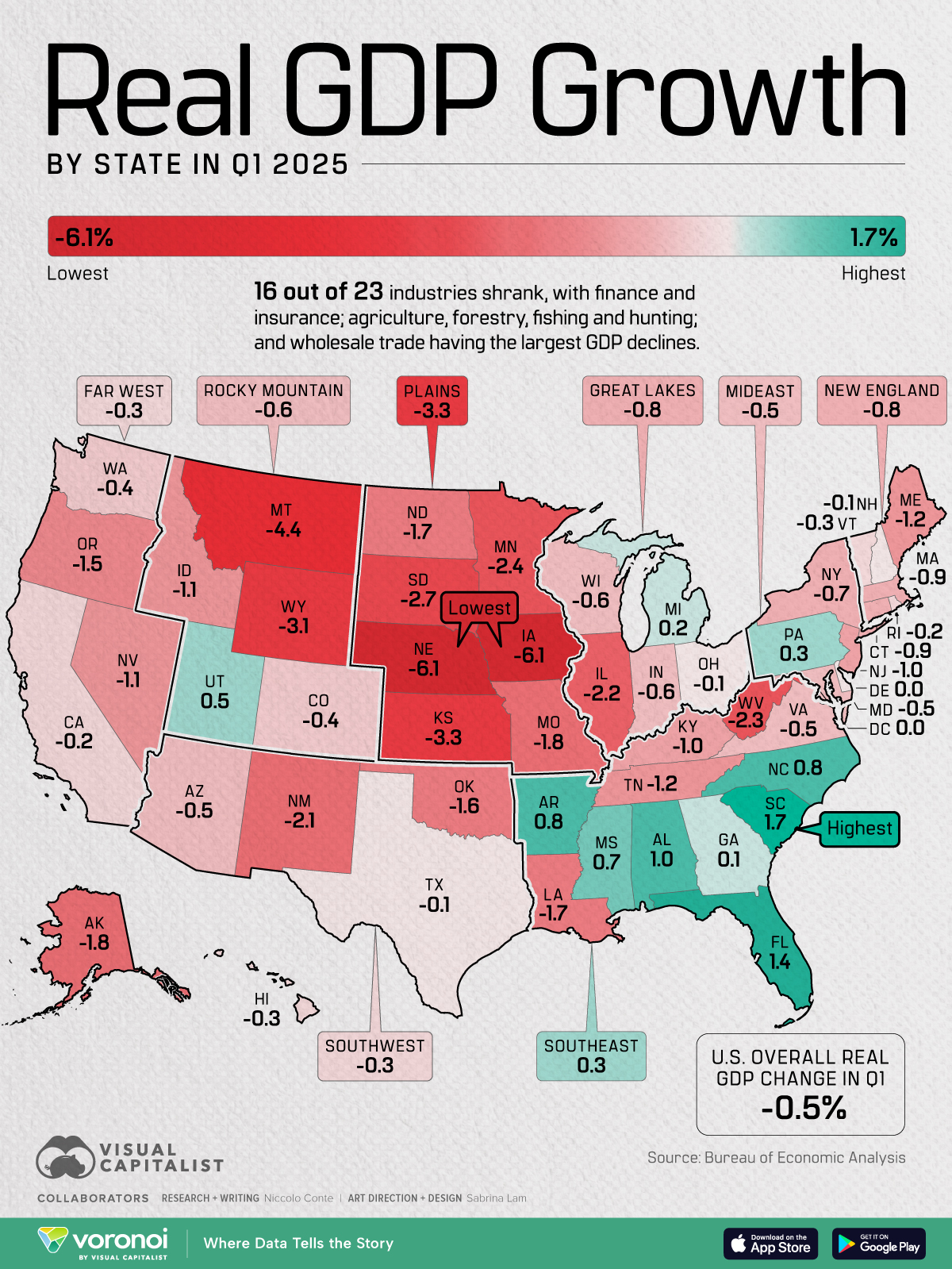![]()
See this visualization first on the Voronoi app.

Use This Visualization
Mapped: Real GDP Growth by State in Q1 2025
This was originally posted on our Voronoi app. Download the app for free on iOS or Android and discover incredible data-driven charts from a variety of trusted sources.
Key Takeaways
- South Carolina (+1.7%) led the nation in real GDP growth, driven primarily by gains in real estate and rental and leasing.
- Iowa and Nebraska saw the steepest declines (-6.1% each), largely due to downturns in agriculture along with forestry, fishing, and hunting.
- Overall the U.S. economy contracted by 0.5%, with 39 states posting declines.
The first quarter of 2025 saw a challenging start for the U.S. economy. Nationally, real GDP contracted by 0.5%, marking a slowdown from the previous quarter’s modest growth.
Only 10 states posted positive economic growth, while the majority experienced declines across major industries. Sharp regional differences are noticeable with some areas buoyed by service-sector gains and others hit hard by downturns in agriculture and manufacturing.
The Bureau of Economic Analysis data highlights which states weathered early-2025’s economic turbulence and which were most negatively affected.
Southern States Show Resilience in Q1 GDP Growth
The Southeast region outperformed much of the country, with Florida (+1.4%), Alabama (+1.0%), and South Carolina (+1.7%) leading growth.
The data table below details quarterly changes in real GDP for all 50 states and the District of Columbia, measured at an annualized rate.
| State/Region | Real GDP Change in Q1 2025 |
|---|---|
| South Carolina | 1.7% |
| Florida | 1.4% |
| Alabama | 1.0% |
| Arkansas | 0.8% |
| North Carolina | 0.8% |
| Mississippi | 0.7% |
| Utah | 0.5% |
| Pennsylvania | 0.3% |
| Southeast region | 0.3% |
| Michigan | 0.2% |
| Georgia | 0.1% |
| Delaware | 0.0% |
| District of Columbia | 0.0% |
| New Hampshire | -0.1% |
| Ohio | -0.1% |
| Texas | -0.1% |
| Rhode Island | -0.2% |
| California | -0.2% |
| Vermont | -0.3% |
| Southwest region | -0.3% |
| Far West region | -0.3% |
| Hawaii | -0.3% |
| Colorado | -0.4% |
| Washington | -0.4% |
| Mideast region | -0.5% |
| Maryland | -0.5% |
| Virginia | -0.5% |
| Arizona | -0.5% |
| Indiana | -0.6% |
| Wisconsin | -0.6% |
| Rocky Mountain region | -0.6% |
| New York | -0.7% |
| New England region | -0.8% |
| Great Lakes region | -0.8% |
| Connecticut | -0.9% |
| Massachusetts | -0.9% |
| New Jersey | -1.0% |
| Kentucky | -1.0% |
| Idaho | -1.1% |
| Nevada | -1.1% |
| Maine | -1.2% |
| Tennessee | -1.2% |
| Oregon | -1.5% |
| Oklahoma | -1.6% |
| North Dakota | -1.7% |
| Louisiana | -1.7% |
| Missouri | -1.8% |
| Alaska | -1.8% |
| New Mexico | -2.1% |
| Illinois | -2.2% |
| West Virginia | -2.3% |
| Minnesota | -2.4% |
| South Dakota | -2.7% |
| Wyoming | -3.1% |
| Plains region | -3.3% |
| Kansas | -3.3% |
| Montana | -4.4% |
| Iowa | -6.1% |
| Nebraska | -6.1% |
Gains were largely driven by real estate, rental, and leasing sectors, along with steady consumer spending.
South Carolina, in particular, saw the highest growth rate in the nation, continuing a trend of strong post-pandemic expansion in the state’s economy.
Agriculture-Heavy States See GDP Decline
The Plains region faced significant contraction, with Iowa and Nebraska each recording -6.1% GDP declines.
These steep drops were linked to downturns in agriculture, forestry, fishing, and hunting, which remain central to these states’ economies.
Drought conditions and weaker commodity prices may have amplified the slowdown. Montana (-4.4%) and Wyoming (-3.1%) also posted sharp declines.
Mixed Results in Manufacturing Hubs
Manufacturing-heavy states in the Great Lakes saw varied results. Michigan managed a slight increase (+0.2%) thanks to gains in auto production and related industries.
In contrast, Illinois (-2.2%) and Minnesota (-2.4%) saw contractions, reflecting weaker demand and supply chain adjustments.
Nationwide, goods-producing industries struggled compared to service-based sectors.
Learn More on the Voronoi App ![]()
To learn more about the U.S. economy and its changes, check out U.S. Business Growth by Industry Since 2019 on Voronoi, the new app from Visual Capitalist.